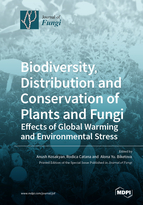Biodiversity, Distribution and Conservation of Plants and Fungi; Effects of Global Warming and Environmental Stress
A special issue of Journal of Fungi (ISSN 2309-608X). This special issue belongs to the section "Environmental and Ecological Interactions of Fungi".
Deadline for manuscript submissions: closed (31 January 2022) | Viewed by 41840
Special Issue Editors
Interests: taxonomy; biodiversity; mycology; protistology; microbial eukaryotes; phylogeny; genomics; transcriptomics; gene expression
Special Issues, Collections and Topics in MDPI journals
Interests: conservation; biodiversity; plant biotechnology; in vitro techniques; threatened plants, medicinal plants species; urban lakes; environment
Special Issues, Collections and Topics in MDPI journals
2. Mycological Society of Israel, P.O.Box 164, Pardesiya 42815, Israel
Interests: taxonomy, biodiversity, and phylogeny of Boletales; conservation, evolution and diversification of Agaricomycetes; synthetic biology, phage engineering
Special Issues, Collections and Topics in MDPI journals
Special Issue Information
Dear Colleagues,
The estimation of global biodiversity and its conservation is an old but still unresolved question in biology. From one hand, the number of described species increase constantly especially with accumulation of the modern morphological and molecular data, while from the other hand the existence of many species is threatened in the results of anthropogenic pressure and environmental stress (i.e. global warming, pollution, salinity and drought, emerging parasite alteration, etc.).
Since ancient times, plants provide us many direct benefits (food, medicine, clothes, raw materials, clean water, climate amelioration etc). According to Botanic Gardens Conservation International, at least 25% of the total plant species in the world are now threatened with extinction. The conservation of these plants should be a key component of efforts for biodiversity conservation.
Fungi as well, are essential components of the ecosystem and widely used by humanity (food, medicine, mycelium-based materials, production of biofuel, enzymes, bioremediation, etc.), however they are especially poorly represented in national and international red lists in comparison with plants and animals (i.e. there are only 425 species of Fungi in IUCN Red List, while Plantae – more than 54,000 and Animalia - more than 79,800 species). This is due to a significant lack of knowledge in fungal biodiversity and distribution, especially in tropical areas. And there are no comprehensive studies on how global climate changes affect fungi and their interactions with plants.
This forthcoming Special Issue aims to combine wide spectrum of studies related to biodiversity and conservation of plants and fungi, plant-fungal interactions, effects of global warming, pollution, parasites, and other abiotic factors affecting their conservation, as well as phylogenetic, genomic and transcriptomic studies with the direction of biodiversity estimation and gene expression studies related to environmental stressors.
We invite to submit research articles, review articles as well as short communications for this special issue, which will bring together different but still very interconnected topics and will be a great interest for a broad audience.
You may choose our Joint Special Issue in Plants.
Dr. Anush Kosakyan
Dr. Rodica Catana
Dr. Alona Biketova
Guest Editors
Manuscript Submission Information
Manuscripts should be submitted online at www.mdpi.com by registering and logging in to this website. Once you are registered, click here to go to the submission form. Manuscripts can be submitted until the deadline. All submissions that pass pre-check are peer-reviewed. Accepted papers will be published continuously in the journal (as soon as accepted) and will be listed together on the special issue website. Research articles, review articles as well as short communications are invited. For planned papers, a title and short abstract (about 100 words) can be sent to the Editorial Office for announcement on this website.
Submitted manuscripts should not have been published previously, nor be under consideration for publication elsewhere (except conference proceedings papers). All manuscripts are thoroughly refereed through a single-blind peer-review process. A guide for authors and other relevant information for submission of manuscripts is available on the Instructions for Authors page. Journal of Fungi is an international peer-reviewed open access monthly journal published by MDPI.
Please visit the Instructions for Authors page before submitting a manuscript. The Article Processing Charge (APC) for publication in this open access journal is 2600 CHF (Swiss Francs). Submitted papers should be well formatted and use good English. Authors may use MDPI's English editing service prior to publication or during author revisions.
Keywords
- biodiversity
- distribution
- species conservation
- ecology of plants and fungi
- endangered species
- red list
- plant–fungal interactions
- lichens
- reactions on environmental stress
- effects of global warming
- transcriptomics/gene expression









